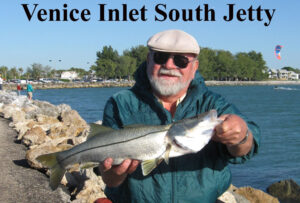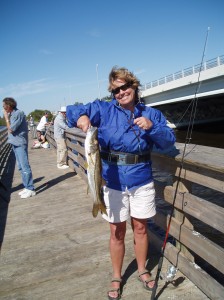Winter or something like it finally arrived in Florida this week. During those windy days with temperatures in the 50’s, only the hardy ventured out on the piers and beaches. These cold fronts cause rapid changes in water temperature that can put fish in survival mode and not a feeding mood. Just as if you were thrown into cold water, your first reaction would not be hunger. The shallows chill faster which forces the fish into deeper channels but doesn’t improve their appetite. Sheepshead seem to be immune to this pattern and continue to provide sport for the hardy pier anglers.
The best part is that as water temperatures rise following a cold snap, fish immediately resume their never ending search for a meal. Initially, waters rise in the protected bays and canals with dark bottoms and seawalls. Soon after, these warmer waters begin to work their way into the larger bays with outgoing tidal flow. Use this to predict where game fish might congregate. Protected, south facing mangrove shorelines adjacent to flats with slightly deeper water close to the trees are perfect examples. If you can find some with oyster shell nearby and a layer of dark colored, decomposing mangrove leaves on the bottom, even better. This is where the bait fish, especially juvenile mullet, will be [closely followed by predators].
Access to protected shorelines with mangroves is tough for the angler fishing from shore. Seawalls can be a little easier to find but tend to be on private land. Wading is an excellent option here as long as you find a firm sandy bottom, not bottomless mud. This time of year, the water is pretty chilly, usually in the low 60’s so waders may make your day a little warmer. Assuming a northerly wind in the winter associated with cold fronts, here are a few idea for the best fishing in Florida, most of which are featured in our book “Angler’s Guide to Shore Fishing Southwest Florida-Longboat Key to Boca Grande” available at many fine stores in this area and on our website at www.anglerpocketguides.com
• The small bay at northeast end of Big Sarasota Pass warms quickly and flushes this warm water into the pass on outgoing tides. This area is more protected from a northwest wind.
• The north side of Longboat Pass protected by trees. Check out the east side, particularly the area protected by Leffis Key. This area has a sandy bottom and warms quickly near shore.
• The shoreline on the southern side of Cedar Point Environmental Park
• The north side of New Pass especially the bay west of the parking lot and the shoreline east of the bridge. Both areas have shallow warm water entering the channel and have sandy wadable bottom.
• The north side of the Venice Inlet on the beach end is protected from a north wind with access to deep water. If the winds come from the west or northwest, try the west side of the ICW which is also accessible from this area.
• Boca Grande Pass has an area near the phosphate docks protected by trees and dunes that can get really toasty out of the wind. Sheepshead congregate around these docks so target them with small shrimp on small hooks on the bottom.
• The two public piers on Bayshore Rd. west of US 41 in Port Charlotte. These are well protected and near shallow flats that warm quickly. Be warned though that with some of our extra low tides in the winter, these piers will extend out over dry land.

Angler Pocket Guides
A series of waterproof pocket sized guides for recreational anglers
